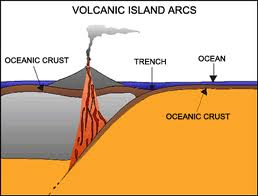nMountnTambora was the tallest peak on the island of Sumbawa and one of thentallest in all of Indonesia, a nation made up of a chain (or archipelago) of islands innSoutheast Asia. (Note, on the map, that part of Australia is peeking up in the lower right corner.)
n
n
n
n Butnsomething was happening far, far below that 14,100-foot peak. ThenPacific Ocean plate was diving below the tectonic plate on whichnSumbawa and the other Indonesian islands sat, and the rubbingntogether of the rocks was heating up the area, melting rocks, andnsending magma up crevices.
Butnsomething was happening far, far below that 14,100-foot peak. ThenPacific Ocean plate was diving below the tectonic plate on whichnSumbawa and the other Indonesian islands sat, and the rubbingntogether of the rocks was heating up the area, melting rocks, andnsending magma up crevices.
 Butnsomething was happening far, far below that 14,100-foot peak. ThenPacific Ocean plate was diving below the tectonic plate on whichnSumbawa and the other Indonesian islands sat, and the rubbingntogether of the rocks was heating up the area, melting rocks, andnsending magma up crevices.
Butnsomething was happening far, far below that 14,100-foot peak. ThenPacific Ocean plate was diving below the tectonic plate on whichnSumbawa and the other Indonesian islands sat, and the rubbingntogether of the rocks was heating up the area, melting rocks, andnsending magma up crevices.n
nThe crater at the top of the peak (called a caldera) began tonrumble. At one point, a dark cloud formed above the volcano.
n
nThenvolcano had been dormant for hundreds and hundreds of years, but itnlooked like it was waking up. Sure enough, on this date in 1815, anneruption spit out ash and gas. n
n
nThenpeople of the nearby village of Tambora—and the people of thenisland of Sumbawa—and even the people of the other Indonesiannislands, hundreds of miles away—heard thunderous booms. Ash startednto fall from the skies.
n
nFivendays later, the largest volcanic eruption in history shooknTambora-the- mountain and, sadly, eliminated Tambora-the-village.
n
nThenTambora eruption was TEN TIMES more powerful than the more famousnKrakatoa eruption of 1883!
n
n
n OnnApril 10, 1815, even the people on Sumatra island, more than 1,600nmiles away (2,600 km), heard the sounds of the explosion. (Mostnthought at first that it was the sound of guns being fired.) Threencolumns of flame rose up from the mountain, which soon became coverednwith “liquid fire.” Pumice stones fell from the skies, followednby more volcanic ash. Some of the pumice was as large as 8 inches (20ncm) in diameter! Hot gas and rock flowed down all sides of thenmountain and into the ocean. n
OnnApril 10, 1815, even the people on Sumatra island, more than 1,600nmiles away (2,600 km), heard the sounds of the explosion. (Mostnthought at first that it was the sound of guns being fired.) Threencolumns of flame rose up from the mountain, which soon became coverednwith “liquid fire.” Pumice stones fell from the skies, followednby more volcanic ash. Some of the pumice was as large as 8 inches (20ncm) in diameter! Hot gas and rock flowed down all sides of thenmountain and into the ocean. n
 OnnApril 10, 1815, even the people on Sumatra island, more than 1,600nmiles away (2,600 km), heard the sounds of the explosion. (Mostnthought at first that it was the sound of guns being fired.) Threencolumns of flame rose up from the mountain, which soon became coverednwith “liquid fire.” Pumice stones fell from the skies, followednby more volcanic ash. Some of the pumice was as large as 8 inches (20ncm) in diameter! Hot gas and rock flowed down all sides of thenmountain and into the ocean. n
OnnApril 10, 1815, even the people on Sumatra island, more than 1,600nmiles away (2,600 km), heard the sounds of the explosion. (Mostnthought at first that it was the sound of guns being fired.) Threencolumns of flame rose up from the mountain, which soon became coverednwith “liquid fire.” Pumice stones fell from the skies, followednby more volcanic ash. Some of the pumice was as large as 8 inches (20ncm) in diameter! Hot gas and rock flowed down all sides of thenmountain and into the ocean. nn
nAndnthe ash fell. And fell. And fell some more.
n
nSomenof the tiniest particles of ash stayed high up in the atmosphere, andnblew around in the wind currents, and blocked the sun. The next year,n1816, was called “The Year Without a Summer” in the United Statesnand Europe, because the volcanic eruption put so much ash and sulfurninto the atmosphere that more sunshine was reflected away from thenEarth, back into space, and the temperatures dropped all over thenworld. This phenomenon is called a volcanic winter—and during thisnone, it snowed in Boston, Massachusetts, in July!
n
nLikenany global climate change, this volcanic winter caused hardship andndeath as some crops failed, some livestock died, and thousands ofnpeople starved.
n
n
nTamboranis now called the Pompeii of the East because archaeologists havenbegun to excavate the lost culture of Tambora that had been buried by pyroclastic flows. The team of scientistsnhad to cut through a “pavement” of pumice and hardened ash aboutn10 feet (3 m) thick!
n
n Archaeologists have found bronze bowls, ceramic pots, iron tools, and othernartifacts from the once-thriving village–exactly as they were almost 200 years ago. n
Archaeologists have found bronze bowls, ceramic pots, iron tools, and othernartifacts from the once-thriving village–exactly as they were almost 200 years ago. n
 Archaeologists have found bronze bowls, ceramic pots, iron tools, and othernartifacts from the once-thriving village–exactly as they were almost 200 years ago. n
Archaeologists have found bronze bowls, ceramic pots, iron tools, and othernartifacts from the once-thriving village–exactly as they were almost 200 years ago. nn
n
n
nAlson on this date:
n
n
nAnniversary of the 1893 decision to get the U.S. on the metric system
n
n
n
n
n
n
nPhilanthropistnElihu Yale’s birthday
n
n
n
n
n
n
n
n
n
n
n
n
n
nWriter,nleader, and educator Booker T. Washington’s birthday























